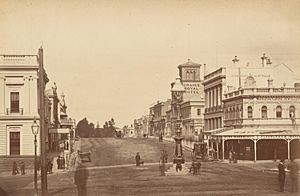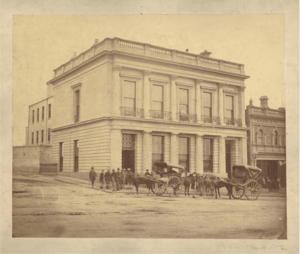National Centre for Photography facts for kids
The National Centre for Photography is a special place in the city of Ballarat, Australia. It's all about photography! Here, you can see amazing photo exhibits, learn how to take better pictures, and see important photographs that are kept safe for the future.
Contents
How the Centre Began

The idea for the National Centre for Photography started with the Ballarat International Foto Biennale, a big photo festival. In 2018, the festival organizers bought a historic building for $1.3 million to be the Centre's new home.
The Centre was already being used for the 2019 festival. One of the first exhibitions was called Capital. It showed how photographers use their art to explore ideas about money and culture.
To get the building ready, an artist named Robbie Rowlands did an amazing project called Incremental Loss. He carefully took apart parts of the building's interior, like walls and floors, turning the process itself into a work of art. Another exhibition, Stock Market by Mathieu Asselin, used photos to tell the story of a large company that makes products for farms, like insecticides and genetically changed seeds.
Support from the Government
In 2020, the government of Victoria gave the project a huge boost. They provided $6.7 million to help create the National Centre for Photography. This was the largest amount of money ever given to a photography group in Australia at the time!
This funding was a big deal. It helped turn the dream of the Centre into a reality. The government knew the Centre would attract many visitors to Ballarat, which is good for local businesses and jobs. It was predicted to bring in over $75 million to the area over 15 years.
Fiona Sweet, the director of the photo festival and the new Centre, said the money was a "real investment in culture." It showed that art is important, especially in regional areas like Ballarat.
A Historic Building with a New Purpose
The Centre is located in a beautiful old building that used to be the Union Bank. It was built in the 1860s during Australia's gold rush era. The building has a classic Greek style and is considered a very important historic site.
Before it became a photo gallery, the building needed a lot of work. An artist, Robbie Rowlands, was hired to help with the renovation. In a unique art project, he peeled back walls and even used a chainsaw on ceilings and floors! He took pictures of this process, and these photos were displayed at the 2019 festival.
The government money was used to finish the renovations. Now, the building has four galleries for showing photos from artists all over the world. It also has:
- Spaces for workshops, including a darkroom for developing black-and-white photos.
- A program for artists to live and work at the Centre.
- A library of photo books.
- A place to store the festival's own collection of photographs.
- A modern 3D "immersive" gallery that uses digital technology to show art.
Past Exhibitions
The Centre has hosted many exciting exhibitions. Here are a few from its opening year in 2019:
- Incremental Loss: The art project by Robbie Rowlands that documented him taking apart the building's interior.
- Capital: A group show featuring many artists who explored ideas about value and money through photography.
- Stock Market: Mathieu Asselin's photo series about the growth of a global biotechnology company.
- History of Misogeny: An exhibition by Laia Abril that was shown in the building's downstairs gallery.
See also
- Ballarat
- Ballarat International Foto Biennale
- Photography in Australia
- Centre for Contemporary Photography
- Brummels Gallery
- Church Street Centre for Photography
- The Photographers' Gallery and Workshop
- Australian Centre for Photography
- Queensland Centre for Photography
- Monash Gallery of Art


